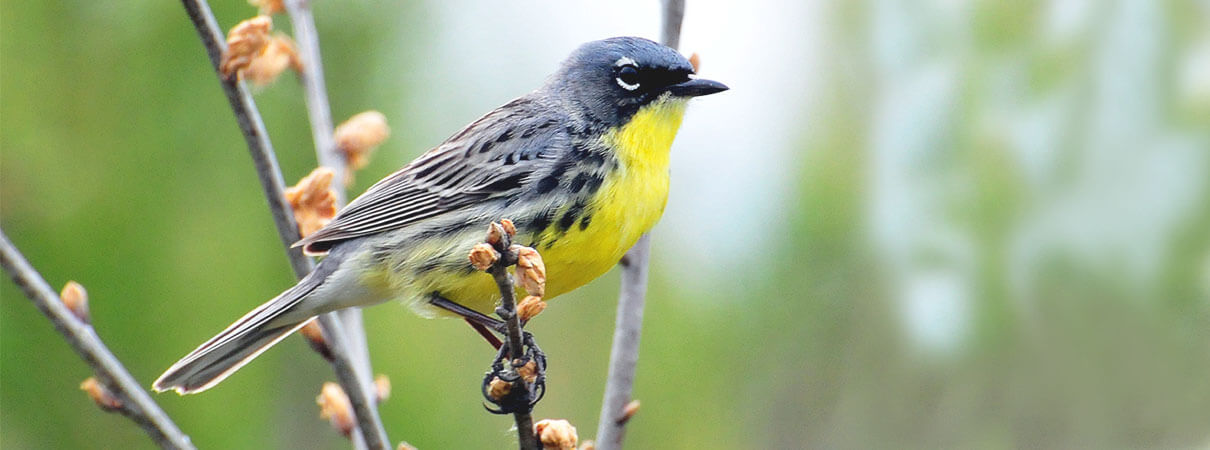Goat Farms and Hurricanes: Q+A on Kirtland's Warbler Recovery
The Kirtland's Warbler is being considered for delisting from the federal endangered species list, after reaching a population more than double its recovery goal. But it's still among the rarest, most range-restricted migratory songbirds in North America, with only about 2,300 breeding pairs alive today.
How can we be sure Kirtland's Warbler recovery will continue? To find out, I spoke with one of the leading experts on the species: ABC's David Ewert. Here's our conversation about the warbler's conservation needs — along with some fascinating facts about the bird's natural history.

Most Kirtland's Warblers nest in northern Michigan, in large blocks of young jack pine forest, many of which are now managed with the bird in mind. Photo by Frode Jacobsen
Erica Cirino: Where have you studied Kirtland's Warblers, and what have you observed?
David Ewert: I started researching the species in 2002 in the Bahamas, where it lives in winter in broadleaf coppice forests — especially dense, shrubby habitat — on the central islands of Eleuthera, Long, Cat, and San Salvador.
As on the summer nesting grounds [in the Great Lakes region], it selects dense, early-successional habitat. Kirtland's Warblers are most frequently seen in the Bahamas where there are higher concentrations of certain fruiting shrubs such as wild sage, black torch, and snowberry, which the warblers prefer for feeding. During late winter, as it becomes drier, Kirtland's Warblers may concentrate in areas where water is close to the surface and where food, including fruit and arthropods, is relatively common.
EC: Are there any other niches in the Bahamas that Kirtland's Warblers occupy?
DE: Interestingly, Kirtland's Warblers are relatively frequent in active goat farms. The goats may sustain early succession habitat by browsing shrubs. Because goats require water, goat farms often sit in areas with a high water table. Such locations often support food production for the Kirtland's Warblers during the late winter dry period.
EC: How do hurricanes impact Kirtland's Warblers?
DE: Nathan Cooper, a post-doctoral student at the Smithsonian Migratory Bird Center, has shown that Kirtland's Warblers don't leave their breeding grounds until late September or even early October. They often arrive in the Bahamas after a few hurricanes have already blown through.
There could be some indirect benefits from rain associated with a hurricane, which stimulates plant growth, leading to more fruits and more insects. It's not clear exactly how much the warblers benefit from this added moisture, but severe storms — including those of the last hurricane seasons — fortunately do not seem to have damaged the Kirtland's Warbler population.

In recent years, some Kirtland's Warbler pairs have been nesting in Wisconsin as well in northern Michigan, plus a few in Ontario. The birds winter almost exclusively in the Bahamas. Photo by USFWS
EC: Do Kirtland's Warblers face other threats in the Bahamas? If so, what's being done to address them?
DE: As in the United States, development is a potential threat to Kirtland's Warbler recovery in the Bahamas. To ensure the warblers' survival in the long term, we need to map — especially in the central Bahamas — the most likely potential wintering habitat, anticipate potential effects of development and climate change, and work to create and preserve safe habitat in these areas. And of course we also need to ensure that sufficient habitat remains on their breeding grounds and along their migration route.
In March, I spoke to a manager of the Bahamas Electricity Corporation, asking to review management of electric transmission line rights-of-way across the four islands where Kirtland's Warblers are most common. In these areas, cutting vegetation minimizes the chances that trees will fall on power lines, but this activity also helps maintain fruiting shrubs preferred by the warblers. It is a win-win situation.
We were pleased to know that herbicides are not used in managing the rights-of-way, as that could adversely affect the growth of fruiting shrubs. We have also been encouraged by goat farmers who have expressed interest in managing their goat pastures in ways beneficial to their goats and Kirtland's Warblers, and we will incorporate their input as we develop the strategy for protecting Kirtland's Warblers in the Bahamas.
EC: What's next for Kirtland's Warbler conservation?
DE: The scientific community continues to make great progress in understanding Kirtland's Warbler ecology and the challenges faced by these birds. Even though more research is needed, we will use the available information to identify where Kirtland's Warblers are most threatened and thus where conservation activities are most needed. That's where the newly formed Kirtland's Warbler Conservation Team and Kirtland's Warbler Alliance come into play.
The Conservation Team — made up of a wide range of stakeholders, including academic scientists and government and nongovernmental organizations, including ABC — is completing conservation plans that list actions needed to protect the birds throughout their life cycle, including socioeconomic factors.
The Alliance, just in its initial stages of forming a nonprofit organization, is designed to raise funds supporting projects recommended by the Kirtland's Warbler Conservation Team as well as to create an endowment fund. The endowment fund will support Kirtland's Warbler recovery efforts that will lose federal funding if the species is delisted, perhaps as soon as 2019. ABC has initiated fundraising for both projects and the endowment.
Visit ABC's Kirtland's Warbler species profile to learn more about this songbird.
This interview was originally published in the Winter 2018-2019 edition of Bird Conservation.
Dave Ewert is ABC's Kirtland's Warbler Program Director and Senior Conservation Scientist. He works closely with Joseph Wunderle, a research scientist at the U.S. Forest Service's International Institute of Tropical Forestry in Puerto Rico.
ABC's work as part of the Kirtland's Warbler Conservation Team is made possible through the generosity of the Harry A. and Margaret D. Towsley Foundation. If you are interested in contributing to ABC's efforts to support Kirtland's Warbler conservation, contact Dan Trudeau at dtrudeau@abcbirds.org.
 | Erica Cirino is a freelance science writer and artist working in New York and internationally. |


















































